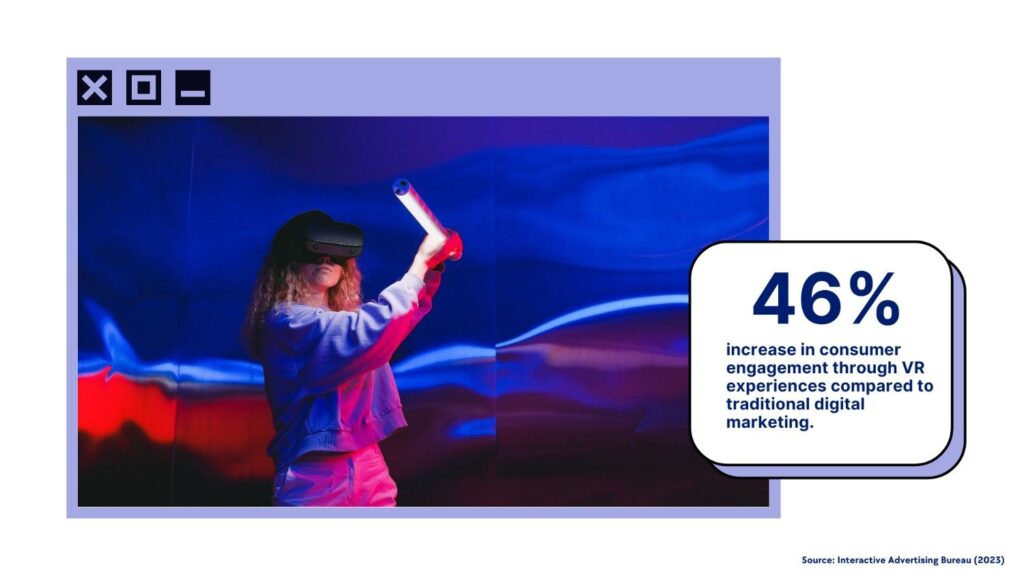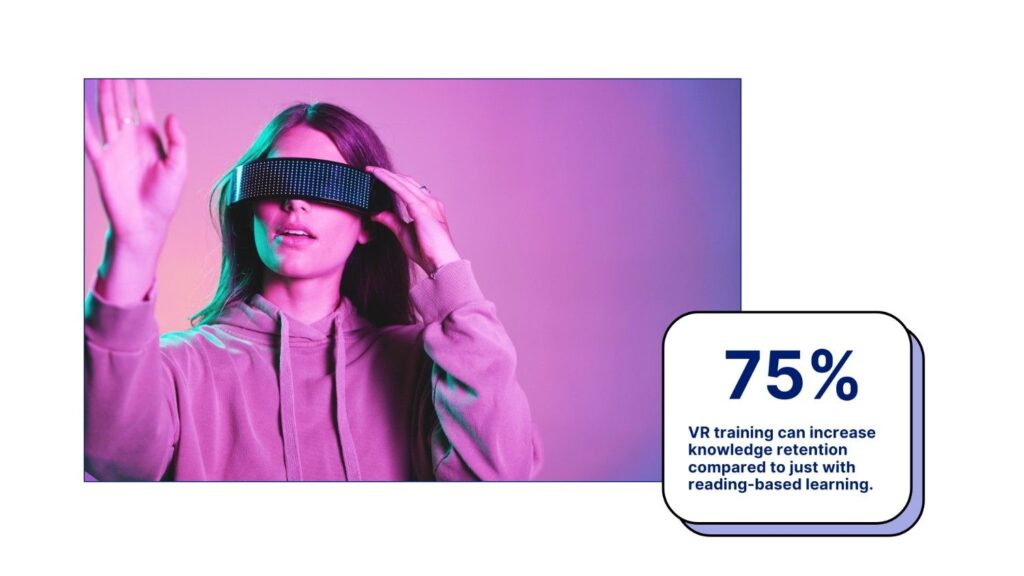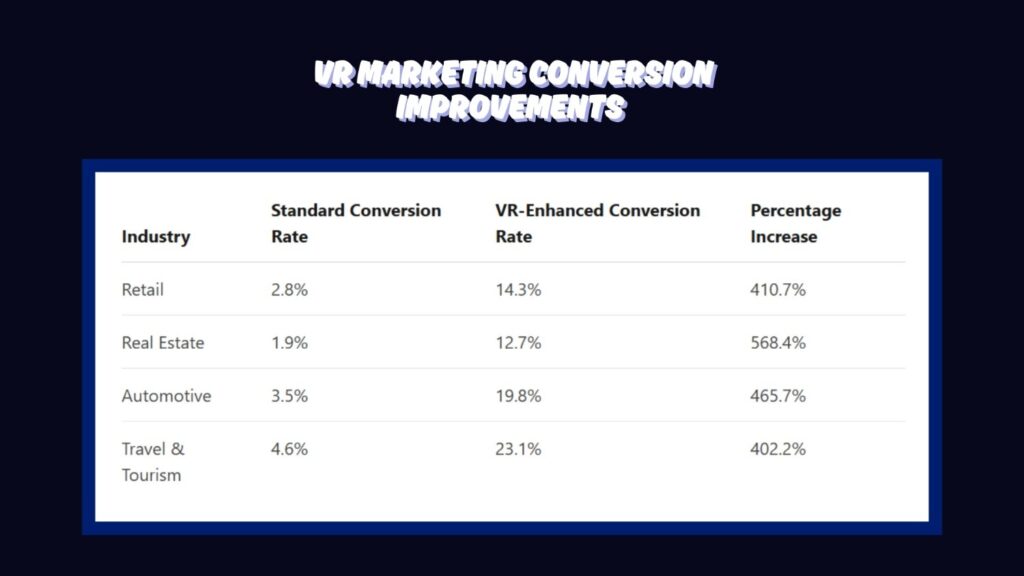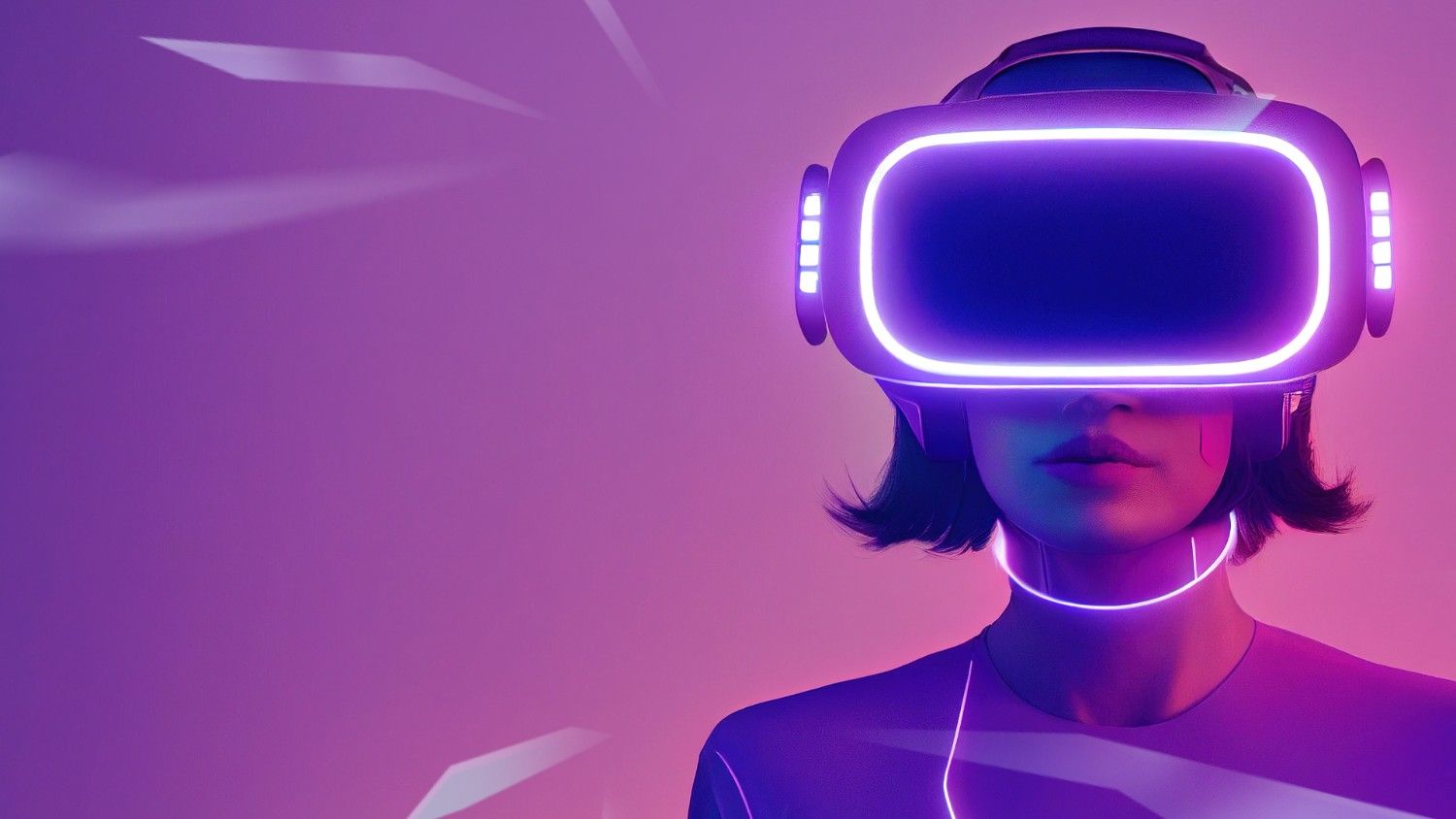What if your customers could walk through your store from their living room? Or your new hires could practice real-life scenarios before even stepping on the job?
No, we aren’t talking about teleportation. Just a VR headset!
VR video isn’t the same as a full VR game or a simple 360° video. VR is a practical, scalable solution for brands.
Here’s how businesses are making it work:
- Walmart uses VR to simulate real-world retail scenarios like Black Friday
- IKEA and real estate companies offer virtual try-before-you-buy experiences
- BMW and Adidas host immersive VR events and product launches
- Ford uses VR prototyping to cut development time and catch design flaws early
- Startups and small businesses are using tools to build simple, scalable VR experiences.
The Customer Engagement Revolution

Immersive Brand Experiences
Brands are moving way too fast. They aren’t sticking to traditional ads anymore. What are they doing?
They are creating a website where their customers come in, explore, and try personalised products. All happens without actually touching the product or buying it.
Not overstating, they drive serious results.
1. IKEA’s VR Home Design Tools
- IKEA introduced the IKEA VR Experience on Steam
- They are letting customers walk through and design virtual kitchens to scale
- Users can explore color schemes, cabinet styles, and room layouts
- They can make furniture shopping less about imagination and more about immersion.
2. Marriott’s VR Travel Experiences
- Marriott launched VR Postcards and short 360-degree travel videos
- They transported users to destinations like Hawaii and London
- These experiences were shown in hotel lobbies using VR
- Guests take a “test-drive” of a location emotionally before booking a trip
Virtual Try-Before-You-Buy
No one can say when trying products virtually before purchasing becomes the norm. It is now a part of certain industries. All thanks go to the growing accessibility of VR.
1. Fashion & Retail
- Nike used VR in select stores. They let customers virtually try on sneakers and explore product lines in 3D.
- Zara experimented with AR and VR. They showcase new collections, allowing shoppers to view models “wearing” the clothes in-store.
2. Real Estate
- Redfin and Matterport offer virtual home tours viewable in VR headsets or 360° video.
- It’s useful for long-distance clients or those in the early browsing stages.
- This has reduced the need for in-person visits during initial property research.
3. Automotive
- Audi launched VR showrooms for buyers to explore interiors and customization and take test drives from a headset.
- These experiences have led to increased customer confidence and lower return rates.
Check out How AI Is Transforming the Video Production Industry? – LocalEyes
VR in Events & Product Launches
You can’t reach global consumers in person. However, VR has made it so easy. It makes product reveals and trade shows accessible, immersive, and memorable.
1. BMW’s VR Auto Show Experience
- With auto shows canceled during the pandemic, BMW hosted a full VR reveal for the iX3 SUV.
- Viewers could explore the car’s features inside and out.
- They can interact with its design elements and even join virtual Q&A sessions with experts.
Transforming Employee Training with VR
Virtual Reality is putting in so much effort. It has reached the corporate world as well.
How?

[Source: Implementing Virtual Reality in Training| vorecol]
VR is literally helping employees learn faster, feel more confident, and retain knowledge longer. This is why companies are onboarding VR to train their people.
Safer, Scalable Learning
Some jobs come with real risks. Let’s say a construction site or a hospital emergency room.
Training in those environments can be dangerous and logistically complex. VR makes it possible to replicate those high-risk scenarios in a safe, controlled environment.
1. Industries Adopting VR for High-Stakes Training
| Construction | Healthcare | Aviation |
| Trainees can learn how to operate heavy machineryNavigate scaffolding without real-world hazards | Medical students and surgeons use VR to simulate surgeriesThey practice emergency responsesImprove precision without needing live patients | Airlines use VR flight simulatorsTrain pilots under various weather conditions and system failures |
2. Walmart’s Black Friday VR Scenario
- Walmart rolled out VR headsets to over 200 training centers across the U.S.
- They train around 150,000 employees in various areas
- One of the standout simulations was a Black Friday crowd-control scenario
- Employees practice managing chaos, decision-making, and customer interaction under pressure.
- VR outperformed traditional methods, enhancing preparedness and retention.
Soft Skills and Diversity Training
VR isn’t just for technical training. It can actually teach human skills like empathy, communication, and conflict resolution.
- Companies are using VR to replicate real-life situations in front of the employees.
- Make employees deal with racial bias, accessibility issues, and microaggressions at work.
- It helps employees grasp perspectives often missed in text or lectures.
- VR scenarios help employees practice anger management, upselling, and complaint resolution.
- They experience emotions and reactions in real time.
Onboarding at Scale
Introducing new employees to remote or global teams can be time-consuming and inconsistent. VR onboarding solves these problems.
1. Virtual Office Tours and Culture Immersion
- Instead of watching a slideshow, new hires can “walk through” virtual offices.
- Meet digital avatars of leadership, and explore company values in interactive ways.
- Some companies even include gamified culture quizzes and scenario-based decision-making games.
2. Remote Onboarding for Distributed Teams
VR is very handy for companies that prefer working remotely or have multiple locations. It gives the same high-quality onboarding experience.
- It saves on travel and simplifies scheduling
- Allows every new employee to feel connected
Relatable Reads: Corporate Training Videos: Impactful Examples (+Best Practices) – LocalEyes
The 5 Real-World Business Applications of VR (With Case Studies)
Virtual Reality is no longer a futuristic buzzword.
Already used by companies across the globe to solve problems, streamline operations, and connect with people in ways traditional tech can’t.
1. Training & Onboarding
Case Study: Walmart
Walmart rolled out VR training to over 200 learning academies in the U.S. This is basically a VR training company.
One of the standout simulations? A Black Friday rush, where employees managed high-stress customer scenarios in a virtual store.
Results:
- Improved test scores in post-training evaluations
- Reduced time and cost compared to traditional training
Why it works: VR offers scalable, safe, and repeatable training that engages users more than traditional classroom or online methods.
2. Product Development & Prototyping
Case Study: Ford
Ford takes help from VR for their Immersive Vehicle Environment (FiVE) lab. It tests the design ergonomics before any physical model is made. Designers and engineers use VR to walk around and inspect digital prototypes from every angle.
Impact:
- Cuts development cycles
- Saves millions in prototyping and retooling costs
- Allows early detection of design flaws
Why it works: VR enables teams to collaborate and refine products early before costly physical builds.
3. Customer Experience & Virtual Showrooms
Case Study: IKEA Place
IKEA Place uses AR and VR tools to let customers see how furniture will look and fit in their homes. The app places true-to-scale 3D furniture models in users’ real spaces.
Benefits:
- Reduces buyer uncertainty
- Decreases return rates
- Boosts time-on-site and conversions
Why it works: Customers interact with products or spaces in a personalized way that images or videos can’t provide.
4. Healthcare
Use Cases: Surgical Training
Medical professionals use VR platforms like Osso VR to simulate surgeries before entering the operating room.
Impact:
- 3D simulations of various surgical procedures
- Surgeons practice without an actual human being
- Build strong communication and teamwork among surgeons.
- Create muscle memory and procedural understanding.
Why it works: VR creates safe, controlled environments that replicate real-life situations with emotional and physical realism.
5. Events, Conferences & Immersive Marketing
Case Study: Adidas’ VR Running Experience
Adidas came up with a cool VR experience where people could try out their shoes while running through virtual cities. It was all part of a fun marketing campaign that they rolled out at big events and pop-up booths.
Impact:
- Deep emotional engagement with the brand
- High shareability on social platforms
- Increased in-store footfall and brand recall
Why it works: VR turns passive spectators into active participants. It doesn’t just show a product, it makes you feel it.
Check out The 10 Most Effective Types of Video Advertising to Grow Your Business
What Most Businesses Get Wrong About VR Video?
VR video has incredible potential. However, many companies still miss the mark when trying to use it. The problem isn’t the technology itself. It’s how businesses approach it.
1. Believing It’s Only for Big Brands
One of the most common misconceptions.
VR is a playground for tech giants or global brands with million-dollar budgets. It is somewhat true that companies like BMW or Nike have launched high-end VR campaigns. However, the barrier to entry is no longer that high.
Reality Check:
- Unity, Unreal Engine, and 360-degree cameras are now more accessible and affordable.
- Small businesses and startups use VR for virtual demos, training, or tours on a limited scale.
Better Approach: Start with a simple, practical VR experience that solves one specific business problem. Test it, learn from it, and build from there.
2. Failing to Track Success Metrics
VR is engaging. Nevertheless, engagement without measurement is just a gimmick. Companies often launch VR campaigns or training tools without clear KPIs or tracking.
What’s Missing:
- Time spent in the experience
- Interaction points (what users clicked, explored, or skipped)
- Emotional response (via surveys or biofeedback tools)
- Conversion or behavioral shifts post-experience
Better Approach: Before launching, define what success looks like. It can be retention, performance improvement, reduced returns, or customer satisfaction.
3. Overengineering Instead of Starting Small
Many brands aim too high, too fast. They try to build an all-in-one. They don’t even know that a simple 360° product demo would be more effective (and easier to maintain).
The Problem:
- High production costs with unclear ROI
- Long development cycles that delay feedback and iteration
- A final product that’s beautiful, but unused
Better Approach: Start lean. Build a prototype. Use low-fidelity versions or 360° video to validate your concept.
Relatable Read: Video Production for Small Businesses: Creative Solutions That Drive Results – LocalEyes
How Can Any Business Use VR Video?
You don’t need a massive budget or an in-house dev team to start using VR video. What used to be a high-tech luxury is now accessible. You can use it for small businesses, educators, real estate agents, fitness trainers, etc.
Budget-Friendly Tools and Platforms
You don’t have to reinvent the wheel. Some plug-and-play tools and platforms make creating and viewing VR content surprisingly easy.
Affordable Hardware
- Insta360 ONE X2 / X3
- User-friendly 360° cameras
- Great for walkthroughs, training videos, and immersive storytelling
- Meta Quest 2 / 3 (formerly Oculus)
- Lightweight VR headset
- Perfect for immersive content and training simulations
- Business bundles are available
- GoPro Max
- Versatile 360° camera with waterproof capabilities
- Strong stabilization
- Ideal for outdoor or action-based content
VR Platforms for Business
- Vimeo 360
- Host 360° videos with interactive hotspots
- Mobile/headset compatibility
- Tovr
- A no-code platform
- It lets you build interactive VR experiences
- Do not need a developer
- STRIVR / Talespin
- Enterprise-focused VR training platforms
- Good for scaling
- More suitable for mid to large companies
Suggested Starting Points by Business Size & Industry

[Source: 7 Statistical Insights on VR’s Impact on Digital Marketing in 2023]
| Business Model | Sector | Why |
| Small Businesses | Real Estate Agencies | → Create 360° virtual tours of listings |
| Boutiques & Retail | → Use VR for virtual fitting roomsBehind-the-scenes store tours | |
| Gyms & Fitness Coaches | → Offer virtual workout demos → Facility walkthroughs in 360° | |
| Medium Businesses | Restaurants & Hotels | → Add immersive booking experiences → Exploring a table setup, kitchen, or a hotel room virtually |
| Training & Compliance | → Use VR to onboard new hires. → Simulate customer service scenarios, or walk through health/safety protocols | |
| Marketing Agencies | → Offer immersive campaign ideas to clients → Use simple tools to pitch and prototype in VR | |
| Large Enterprises | Manufacturing & Engineering | → Use VR for training on complex machinery |
| Corporate Learning & Development | → Replace expensive workshops with scalable VR training modules | |
| Healthcare Providers | → Train staff using surgical simulations → Build patient empathy through first-person experiences |
Frequently Asked Questions: Virtual Reality in Business
Where is virtual reality most popular?
Virtual reality is most popular in the U.S., China, South Korea, and parts of Europe, especially in gaming, training, healthcare, and marketing industries.
What is virtual reality in business?
Virtual reality in business refers to using immersive, simulated environments for training, product demos, virtual tours, collaboration, and marketing.
What is the future of VR in business?
The future of VR in business involves deeper integration with AI and 5 G into training, remote collaboration, virtual commerce, and customer experiences.
How are AR and VR used in business?
AR and VR are used in business for training, virtual product visualization, remote assistance, customer engagement, and design prototyping.

Founder at LocalEyes Video Production | Inc. 5000 CEO | Emmy Award Winning Producer



